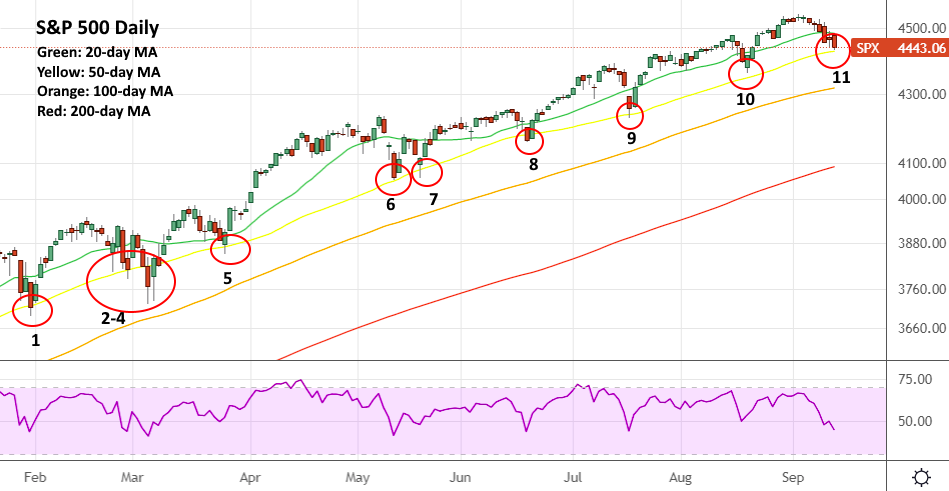The 50-day moving average is probably the most viewed support level in US equities at the moment. Five consecutive lower daily closes on the S&P 500 between September 7 and 14 have taken it back down to this crucial line in the sand. This will be the eleventh time since January that the S&P has sold off and tested the 50-week MA as support. Looking back at these dips and recalling the changing narrative at the time is quite instructive. A lot has changed, but the Fed’s support hasn’t. Even with this most recent sell-off, the index is up around 20% since the lows of that first dip in January.

January, 2021: S&P 500 Hits 3870
You can chart the overarching story of this year’s markets by going back to these dips in US equities. Between January 26 and 29, the S&P came off its then record highs at around 3870, to trade as low as 3690, bouncing off the 50-day MA as support before continuing to new highs. This dip was chalked up to the Fed’s lukewarm comments regarding the state of the economy and a series of weaker-than-expected earnings results.
February, 2021: S&P 500 Hits 3950
The next test of the 50-day would come between the end of February and the beginning of March. Again, the dip followed all-time highs; this time the S&P touched 3950 on February 16 before selling-off to around the 3720 level by March 4. This period was more volatile, with the index testing the 50-day on both February 23 and February 26 before finally breaking below it on March 4. At the time, a combination of surging treasury yields, a lack of convincing guidance by Jerome Powell, and a palpable fear that US stocks were becoming overheated were offered as catalysts for the sell-off. This was also when the rotation from growth to value became a more prominent story in the financial media, with the latter outperforming the former in February.
March, 2021: S&P 500 Hits 3980
Almost immediately after rebounding in early March, the S&P 500 would go on to set another record high, peaking on March 17 at around 3980 before correcting to the 50-day moving average at 3850 by March 25. Tech was hit hardest in this particular sell-off, the Nasdaq leading the rout with names such as Facebook, Apple and Alphabet all in the red. The action was described as a rotation from growth to value, and from lockdown to reopening.
May, 2021: S&P 500 Hits 4230
Following the pair of March all-time highs and retreats to the 50-day, April and May would see another 13% surge to new record-highs at around 4230 on May 7. The new high didn’t hold long, within three days the S&P 500 would again find itself trading right back at the 50-day moving average, which at the time was hovering around 4050. A bounce from this level saw the index trading up at 4170 within a couple of days (meeting the 20-day moving average as resistance), and by May 19 it was retesting the 50-day yet again. Rising inflation and overheated valuations were at the top of the list of catalysts in this month.
June, 2021: S&P 500 Hits 4255
A more-hawkish-than-expected Fed would be the main culprit for June’s retreat back down to the 50-day. This was when the Fed began admitting the possibility of tapering the support it has been providing US markets since the pandemic. Additionally, St. Louis Federal Reserve President Bullard voiced his opinion about a possible interest rate hike in 2022, which had the effect of spooking markets even further. The sell-off was short-lived and smaller in percentage than previous dips. This owing to the fact that the index was coming off a high that at 4250, was only marginally higher than May’s 4230 level. The dip was bought up and the S&P 500 rallied once again.
July, 2021: S&P 500 Hits 4395
COVID-19 reared its ugly head in July as fear returned with sharp spikes in new infections aided by the Delta variant. The sell-off was broad, affecting all S&P sectors as the narrative began to shift to concerns that the progress the global economy had made thus far could be set back if the new variant leads to further lockdowns. After a protracted rally to 4395, the S&P 500 lost half a month’s gains in just three days, hitting a low of 4235 by July 19.
August, 2021: S&P 500 Hits 4480
The see-sawing continued in August with new highs set off the back of better than expected initial jobless claims and continuing jobless claims falling to their lowest levels since the height of the pandemic. The S&P 500 rallied to a high of 4480 on August 16, but then retraced as FOMC policy minutes suggested that a taper could begin as early as later this year. By August 19 the index had retraced to a low of 4368, just above the 50-day moving average, before closing the day at 4420. All three major indices were down on the day.
September, 2021: S&P 500 Hits 4540
September was off to a bad start, particularly where sentiment was concerned. Investors were already weary of the seasonal trend that has the month as one of the year’s worst historical performers. Despite this, and an initial jobless claims miss, stocks rallied to new highs, buoyed by energy and big tech. Then, September 7-14 saw six consecutive lower daily closes, taking the S&P right back to the 50-day moving average at around 4430, where it is still trading at the time of writing.
And Now?
Looking back at 2021, the 50-day moving average has acted as a buy-the-dip support level. This won't necessarily continue, but it is a helpful technical guide going forward. Whether it was rotations between lockdown and reflation, or growth vs value, whether the ensuing sell-off was inflation-related or due to COVID, each time investors have felt emboldened to pile back in. The reasons that have been presented for every run-up and subsequent dip have been different, but the result has been the same.
There is a sense of moral hazard here. Will the Federal reserve step in each and every time the US economy is struggling? So far, many investors are relying strongly on the Fed to provide constant support to the US economy when it is struggling. This has impacted the sentiment around US stocks and encouraged dip buyers. Of course, there is no guarantee the Fed will keep stepping in, but they have so far.
The worry is that when everyone is so firmly on one side of the fence, this is when the market is most ripe for an upset. The danger here is that investors keep buying into stocks, even when they are overvalued, just because they don't want to miss out on potential gains. However, many analysts are expecting a 5-10% correction in stocks at some point in the future. One possible catalyst could be when the Fed eventually signal bond tapering. That is certainly a key narrative that investors are focused on right now.
About HYCM
HYCM is the global brand name of Henyep Capital Markets (UK) Limited, HYCM (Europe) Ltd, Henyep Capital Markets (DIFC) Ltd and HYCM Limited, all individual entities under Henyep Capital Markets Group, a global corporation founded in 1977, operating in Asia, Europe, and the Middle East.
High Risk Investment Warning: Contracts for Difference (‘CFDs’) are complex financial products that are traded on margin. Trading CFDs carries a high degree of risk. It is possible to lose all your capital. These products may not be suitable for everyone and you should ensure that you understand the risks involved. Seek independent expert advice if necessary and speculate only with funds that you can afford to lose. Please think carefully whether such trading suits you, taking into consideration all the relevant circumstances as well as your personal resources. We do not recommend clients posting their entire account balance to meet margin requirements. Clients can minimise their level of exposure by requesting a change in leverage limit. For more information please refer to HYCM’s Risk Disclosure.
